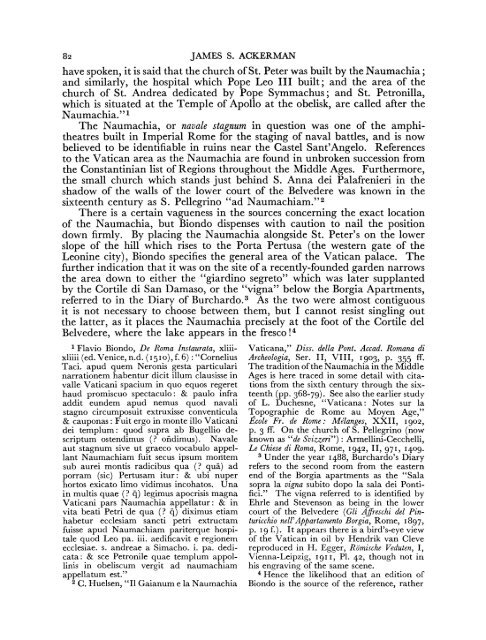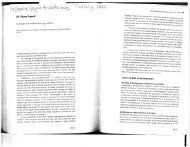The Belvedere as a Classical Villa
The Belvedere as a Classical Villa
The Belvedere as a Classical Villa
You also want an ePaper? Increase the reach of your titles
YUMPU automatically turns print PDFs into web optimized ePapers that Google loves.
82 JAMES S. ACKERMAN<br />
have spoken, it is said that the church of St. Peter w<strong>as</strong> built by the Naumachia;<br />
and similarly, the hospital which Pope Leo III built; and the area of the<br />
church of St. Andrea dedicated by Pope Symmachus; and St. Petronilla,<br />
which is situated at the Temple of Apollo at the obelisk, are called after the<br />
Naumachia."1<br />
<strong>The</strong> Naumachia, or navale stagnum in question w<strong>as</strong> one of the amphi-<br />
theatres built in Imperial Rome for the staging of naval battles, and is now<br />
believed to be identifiable in ruins near the C<strong>as</strong>tel Sant'Angelo. References<br />
to the Vatican area <strong>as</strong> the Naumachia are found in unbroken succession from<br />
the Constantinian list of Regions throughout the Middle Ages. Furthermore,<br />
the small church which stands just behind S. Anna dei Palafrenieri in the<br />
shadow of the walls of the lower court of the <strong>Belvedere</strong> w<strong>as</strong> known in the<br />
sixteenth century <strong>as</strong> S. Pellegrino "ad Naumachiam."2<br />
<strong>The</strong>re is a certain vagueness in the sources concerning the exact location<br />
of the Naumachia, but Biondo dispenses with caution to nail the position<br />
down firmly. By placing the Naumachia alongside St. Peter's on the lower<br />
slope of the hill which rises to the Porta Pertusa (the western gate of the<br />
Leonine city), Biondo specifies the general area of the Vatican palace. <strong>The</strong><br />
further indication that it w<strong>as</strong> on the site of a recently-founded garden narrows<br />
the area down to either the "giardino segreto" which w<strong>as</strong> later supplanted<br />
by the Cortile di San Dam<strong>as</strong>o, or the "vigna" below the Borgia Apartments,<br />
referred to in the Diary of Burchardo.3 As the two were almost contiguous<br />
it is not necessary to choose between them, but I cannot resist singling out<br />
the latter, <strong>as</strong> it places the Naumachia precisely at the foot of the Cortile del<br />
<strong>Belvedere</strong>, where the lake appears in the fresco!"<br />
1 Flavio Biondo, De Roma Instaurata, xliiixliiii<br />
(ed. Venice, n.d. (1510), f. 6) : "Cornelius<br />
Taci. apud quem Neronis gesta particulari<br />
narrationem habentur dicit illum clausisse in<br />
valle Vaticani spacium in quo equos regeret<br />
haud promiscuo spectaculo: & paulo infra<br />
addit eundem apud nemus quod navali<br />
stagno circumposuit extruxisse conventicula<br />
& caupon<strong>as</strong>: Fuit ergo in monte illo Vaticani<br />
dei templum: quod supra ab Bugellio descriptum<br />
ostendimus (? ofidimus). Navale<br />
aut stagnum sive ut graeco vocabulo appellant<br />
Naumachiam fuit secus ipsum moritem<br />
sub aurei montis radicibus qua (? qua) ad<br />
porram (sic) Pertusam itur: & ubi nuper<br />
hortos exicato limo vidimus incohatos. Una<br />
in multis quae (? Q) legimus apocrisis magna<br />
Vaticani pars Naumachia appellatur: & in<br />
vita beati Petri de qua (? ) diximus etiam<br />
habetur ecclesiam sancti petri extructam<br />
fuisse apud Naumachiam pariterque hospitale<br />
quod Leo pa. iii. aedificavit e regionem<br />
ecclesiae. s. andreae a Simacho. i. pa. dedicata:<br />
& sce Petronile quae templum appollinis<br />
in obeliscum vergit ad naumachiam<br />
appellatum est."<br />
Vaticana," Diss. della Pont. Accad. Romana di<br />
Archeologia, Ser. II, VIII, 1903, p. 355<br />
2 C. Huelsen, "I1 Gaianum e la Naumachia<br />
if-<br />
<strong>The</strong> tradition of the Naumachia in the Middle<br />
Ages is here traced in some detail with citations<br />
from the sixth century through the sixteenth<br />
(pp. 368-79). See also the earlier study<br />
of L. Duchesne, "Vaticana: Notes sur la<br />
Topographie de Rome au Moyen Age,"<br />
Ecole Fr. de Rome: Melanges, XXII, 1902,<br />
p. 3 ff. On the church of S. Pellegrino (now<br />
known <strong>as</strong> "de Svizzeri") : Armellini-Cecchelli,<br />
Le Chiese di Roma, Rome, 1942, II, 971, 1409-<br />
3 Under the year 1488, Burchardo's Diary<br />
refers to the second room from the e<strong>as</strong>tern<br />
end of the Borgia apartments <strong>as</strong> the "Sala<br />
sopra la vigna subito dopo la sala dei Pontifici."<br />
<strong>The</strong> vigna referred to is identified by<br />
Ehrle and Stevenson <strong>as</strong> being in the lower<br />
court of the <strong>Belvedere</strong> (Gli Affreschi del Pinturicchio<br />
nell'Appartamento Borgia, Rome, 1897,<br />
p. 19 f.). It appears there is a bird's-eye view<br />
of the Vatican in oil by Hendrik van Cleve<br />
reproduced in H. Egger, Riimische Veduten, I,<br />
Vienna-Leipzig, 1911, P1. 42, though not in<br />
his engraving of the same scene.<br />
4 Hence the likelihood that an edition of<br />
Biondo is the source of the reference, rather



